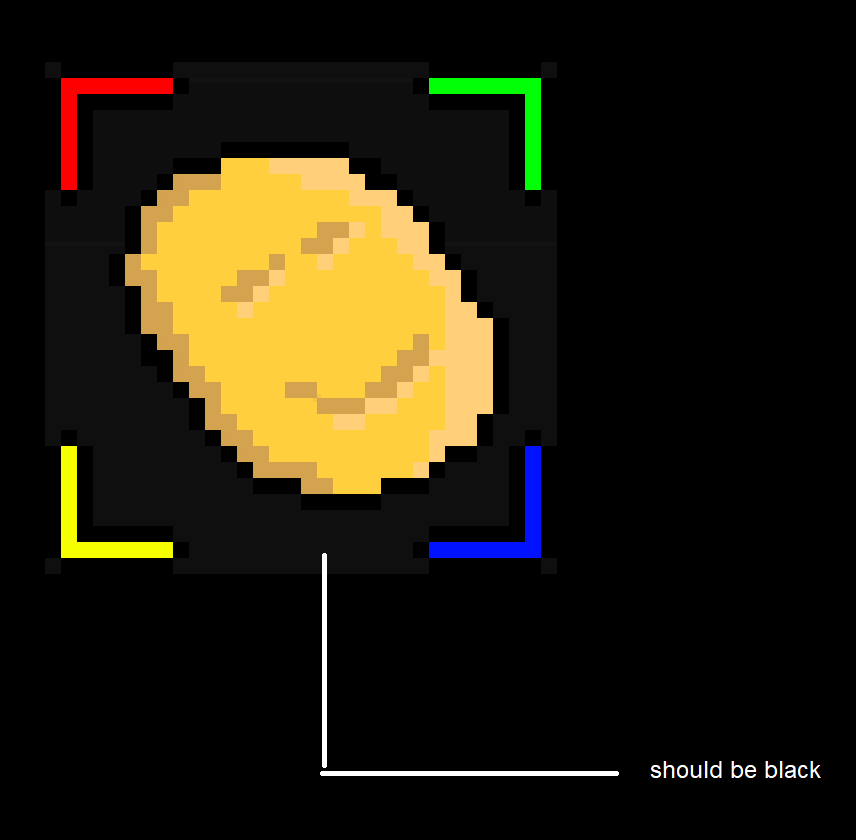Hi,
I try to draw a texture to another texture and I get a gray color in place of the alpha = 0
I tried using blend mode all over the place but this gets confusing
thanks for your help
void DrawTextureToTexture(SDL_Renderer* renderer, SDL_Texture* srcTexture, SDL_Texture* dstTexture, int x, int y) {
if (!renderer || !srcTexture || !dstTexture) {
SDL_Log("Invalid arguments to DrawTextureToTexture");
return;
}
// Get source texture size
float srcW, srcH;
if (!SDL_GetTextureSize(srcTexture, &srcW, &srcH)) {
SDL_Log("Failed to get texture size: %s", SDL_GetError());
return;
}
int w = static_cast<int>(srcW);
int h = static_cast<int>(srcH);
// Create temporary render target texture
SDL_Texture* temp = SDL_CreateTexture(renderer, SDL_PIXELFORMAT_RGBA8888, SDL_TEXTUREACCESS_TARGET, w, h);
if (!temp) {
SDL_Log("Failed to create temp texture: %s", SDL_GetError());
return;
}
SDL_SetTextureBlendMode(srcTexture, SDL_BLENDMODE_BLEND);
SDL_SetTextureBlendMode(temp, SDL_BLENDMODE_BLEND);
SDL_SetRenderDrawBlendMode(renderer, SDL_BLENDMODE_NONE);
// Render srcTexture into temp texture
SDL_Texture* originalTarget = SDL_GetRenderTarget(renderer);
SDL_SetRenderTarget(renderer, temp);
SDL_SetRenderDrawColor(renderer, 0,0,0,0);
SDL_RenderClear(renderer); // Clear the current rendering target with the drawing color.
SDL_RenderTexture(renderer, srcTexture, nullptr, nullptr); // Copy a portion of the texture to the current rendering target at subpixel precision
SDL_SetRenderTarget(renderer, originalTarget);
// Read pixels from temp texture into surface
SDL_SetRenderTarget(renderer, temp);
SDL_Surface* rawSurface = SDL_RenderReadPixels(renderer, nullptr); // Read pixels from temp
SDL_SetRenderTarget(renderer, originalTarget);
if (!rawSurface) {
SDL_Log("Failed to read pixels: %s", SDL_GetError());
SDL_DestroyTexture(temp);
return;
}
// Convert surface to known RGBA32 format
SDL_Surface* surface = SDL_ConvertSurface(rawSurface, SDL_PIXELFORMAT_RGBA8888);
SDL_DestroySurface(rawSurface);
if (!surface) {
SDL_Log("Failed to convert surface to RGBA32: %s", SDL_GetError());
SDL_DestroyTexture(temp);
return;
}
// Manually swap R/B channels if needed (assume BGRA to RGBA)
Uint8* srcPixels = static_cast<Uint8*>(surface->pixels);
SDL_SetTextureBlendMode(dstTexture, SDL_BLENDMODE_BLEND);
SDL_SetTextureAlphaMod(dstTexture, 255);
// Lock destination texture
void* dstPixels = nullptr;
int dstPitch = 0;
if (!SDL_LockTexture(dstTexture, nullptr, &dstPixels, &dstPitch)) {
SDL_Log("Failed to lock dstTexture: %s", SDL_GetError());
SDL_DestroySurface(surface);
SDL_DestroyTexture(temp);
return;
}
// Copy to destination
Uint8* dstBytes = static_cast<Uint8*>(dstPixels);
for (int row = 0; row < h; ++row) {
memcpy(
dstBytes + (y + row) * dstPitch + x * 4,
srcPixels + row * surface->pitch,
w * 4
);
}
SDL_UnlockTexture(dstTexture);
SDL_DestroySurface(surface);
SDL_DestroyTexture(temp);
}
